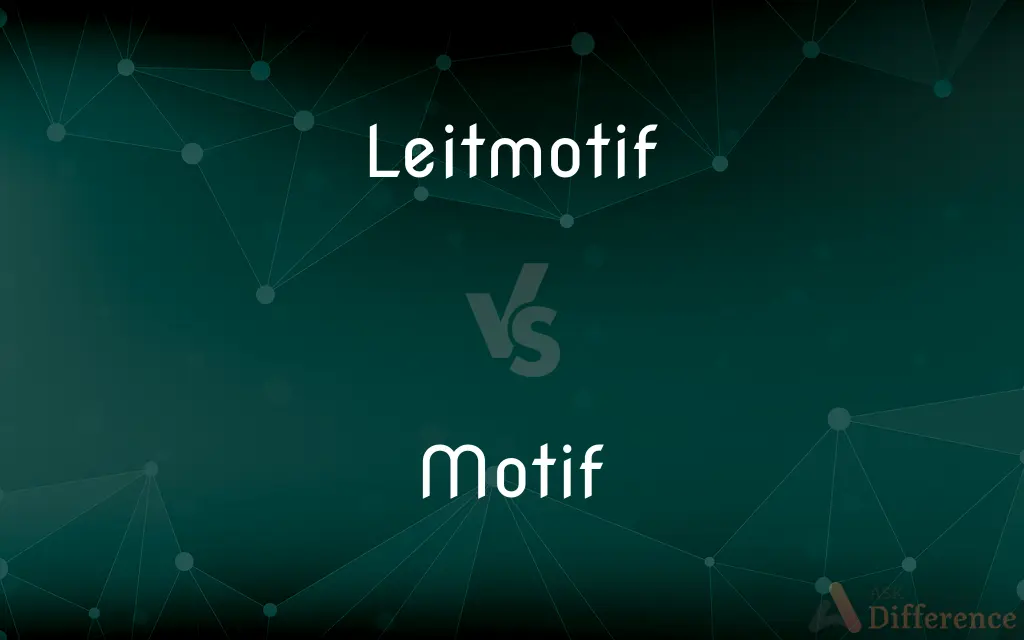Leitmotif vs. Motif — What's the Difference?
Edited by Tayyaba Rehman — By Urooj Arif — Updated on March 14, 2024
A leitmotif is a recurring musical theme associated with a specific character, idea, or situation in a composition, while a motif is a recurring element, theme, or idea in any artistic work.

Difference Between Leitmotif and Motif
Table of Contents
ADVERTISEMENT
Key Differences
Leitmotifs are specifically used in music and opera to symbolically represent characters or themes, helping to unify a composition by recurring at strategic points. In contrast, motifs can be found in various forms of art, including literature, visual arts, and music, serving as a thread that ties together the narrative or artistic elements.
While a leitmotif is often a short, distinctive musical phrase that is directly associated with a particular element within a composition, motifs can be broader, encompassing not just musical phrases but also symbols, colors, words, or even structural elements that recur throughout a work.
The concept of a leitmotif is particularly prominent in operatic and symphonic contexts, where it helps to enhance the storytelling and emotional depth by musically representing specific elements. On the other hand, motifs can be thematic, such as the recurring themes of love, death, or freedom in literature, or visual, like the repeated use of a particular shape or color in a painting.
Leitmotifs require a musical framework to be identified and understood, relying on the listener's ability to recognize the recurring theme and its associations. Conversely, motifs can be identified across a broader spectrum of artistic expressions and do not necessarily rely on a single sensory modality.
Despite these differences, both leitmotifs and motifs serve the critical function of deepening the audience's engagement with the work, enriching the narrative or thematic coherence, and providing insight into the underlying ideas or emotions being conveyed.
ADVERTISEMENT
Comparison Chart
Definition
A recurring musical theme associated with a character, idea, or situation.
A recurring element, theme, or idea in an artistic work.
Usage Context
Music and opera, to symbolize and unify compositions.
Various forms of art, including literature, visual arts, and music.
Specificity
Often a short, distinctive musical phrase.
Can be a wide range of elements (symbols, colors, words, structures).
Representation
Represents specific elements within a musical composition.
Represents broader themes or ideas across a work.
Sensory Modality
Musical, requiring auditory recognition.
Can be visual, auditory, or conceptual, depending on the art form.
Compare with Definitions
Leitmotif
A musical phrase that symbolizes an element within a composition.
The hero's bravery is represented by a bold, recurring leitmotif.
Motif
A recurring element that has symbolic significance in a work.
The motif of light and darkness in the novel symbolizes good and evil.
Leitmotif
A short, recurring musical theme linked to a particular character, situation, or idea.
Wagner's use of leitmotifs in his operas helps audiences associate specific themes with characters.
Motif
An idea, object, or concept that repeats throughout an artistic work.
The rose motif in the painting series represents love and passion.
Leitmotif
A unifying musical element in a composition.
The composer wove leitmotifs throughout the symphony to enhance thematic coherence.
Motif
A thematic or structural element used for coherence.
The motif of redemption recurs throughout the play, tying together various narratives.
Leitmotif
A tool for storytelling and emotional depth in music.
The recurring leitmotif serves as a reminder of the character's journey and struggles.
Motif
A visual, auditory, or conceptual element that is repeatedly used.
The rhythmic motif in the music piece creates a sense of unity and flow.
Leitmotif
An auditory symbol used in operatic and symphonic contexts.
The leitmotif for the antagonist is heard whenever they are mentioned or appear on stage.
Motif
An element that enriches the narrative or thematic depth.
The recurring motif of water symbolizes change and renewal in the film.
Leitmotif
A leitmotif or leitmotiv () is a "short, recurring musical phrase" associated with a particular person, place, or idea. It is closely related to the musical concepts of idée fixe or motto-theme.
Motif
A recurrent thematic element in an artistic or literary work.
Leitmotif
A melodic passage or phrase, especially in Wagnerian opera, associated with a specific character, situation, or element.
Motif
A dominant theme or central idea.
Leitmotif
A dominant and recurring theme, as in a novel.
Motif
(Music) A short rhythmic or melodic passage that is repeated or evoked in various parts of a composition.
Leitmotif
(music) A melodic theme associated with a particular character, place, thing or idea in an opera.
Motif
A repeated figure or design in architecture or decoration.
Leitmotif
(by extension) A recurring theme.
Motif
A recurrent pattern either of molecular sequence, usually of nucleotides or amino acids in proteins, or of molecular structure that usually corresponds to specific biological activity.
Leitmotif
A guiding theme; in Wagnerian opera, a marked melodic phrase or short musical passage which always accompanies the reappearance of a certain person, situation, abstract idea, or allusion in the course of the play; a sort of musical label. Also called Leading motive.
Motif
A recurring or dominant element; an artistic theme.
See how the artist repeats the scroll motif throughout the work?
Leitmotif
A recurring theme in the activities of a person or group.
Motif
(music) A short melodic or lyrical passage that is repeated in several parts of a work.
Leitmotif
A melodic phrase that accompanies the reappearance of a person or situation (as in Wagner's operas)
Motif
A decorative figure that is repeated in a design or pattern.
Motif
(dressmaking) A decorative appliqué design or figure, as of lace or velvet, used in trimming.
Motif
(crystallography) The physical object or objects repeated at each point of a lattice. Usually atoms or molecules.
Motif
(chess) A basic element of a move in terms of why the piece moves and how it supports the fulfilment of a stipulation.
Motif
(biochemistry) In a nucleotide or aminoacid sequence, pattern that is widespread and has, or is conjectured to have, a biological significance.
Motif
Motive.
Motif
In literature and the fine arts, a salient feature or element of a composition or work; esp., the theme, or central or dominant feature;
This motif, of old things lost, is a favorite one for the serious ballade.
The design . . . is . . . based on the peacock - a motif favored by decorative artists of all ages.
Motif
A decorative appliqué design or figure, as of lace or velvet, used in trimming; also, a repeated design.
Motif
A design that consists of recurring shapes or colors
Motif
A theme that is elaborated on in a piece of music
Motif
A unifying idea that is a recurrent element in a literary or artistic work;
It was the usual `boy gets girl' theme
Common Curiosities
What makes a leitmotif different from a general motif?
A leitmotif is a specific type of musical motif that is associated with a particular character, idea, or situation, while a motif can be any recurring element in artistic works.
How do motifs enhance the understanding of an artwork?
Motifs create patterns and connections within a work, deepening the thematic coherence and enriching the audience's engagement and interpretation.
Can motifs be non-musical?
Yes, motifs can be visual, thematic, or structural elements in various forms of art, including literature and visual arts.
How does a leitmotif contribute to storytelling in music?
Leitmotifs help to represent and recall characters, emotions, or themes, enhancing the narrative and emotional connection in music and opera.
Can a leitmotif be considered a motif?
Yes, a leitmotif is a specific kind of motif within the context of musical compositions.
Can a single work have multiple motifs?
Yes, a work can contain multiple motifs, each contributing to different aspects of the theme or narrative.
How do artists choose motifs for their work?
Artists choose motifs based on the themes, messages, or emotional experiences they wish to convey, using them as tools to enhance the work's coherence and impact.
How are motifs identified in literature?
In literature, motifs are identified through the repetition of certain themes, symbols, or narrative elements that contribute to the overarching message or mood.
Do motifs need to be explicitly stated to be effective?
No, motifs can be subtle and may require attentive engagement to be recognized, contributing to the depth and richness of the artistic work.
Can motifs evolve over the course of a work?
Yes, motifs can evolve, gaining new meanings or associations as the work progresses, reflecting changes in narrative or theme.
How does an audience recognize a leitmotif?
Audiences recognize leitmotifs through repetition and their association with specific characters, situations, or ideas, often becoming more attuned to them as the work unfolds.
What role do motifs play in visual arts?
In visual arts, motifs serve as recurring visual elements that can symbolize themes, enhance aesthetic unity, and contribute to the work's deeper meanings.
How can a motif affect the mood of a work?
Motifs can significantly affect the mood by reinforcing thematic elements, creating patterns that elicit specific emotional responses from the audience.
Is the use of leitmotifs limited to classical music?
While leitmotifs are prominent in classical music and opera, they are also used in film scores and other musical genres to enhance storytelling.
Are motifs always intentional?
While motifs are often used intentionally by artists to enhance their work, some motifs may emerge organically as the work develops.
Share Your Discovery

Previous Comparison
Prefect vs. Procurator
Next Comparison
Continue vs. RemainAuthor Spotlight
Written by
Urooj ArifUrooj is a skilled content writer at Ask Difference, known for her exceptional ability to simplify complex topics into engaging and informative content. With a passion for research and a flair for clear, concise writing, she consistently delivers articles that resonate with our diverse audience.
Edited by
Tayyaba RehmanTayyaba Rehman is a distinguished writer, currently serving as a primary contributor to askdifference.com. As a researcher in semantics and etymology, Tayyaba's passion for the complexity of languages and their distinctions has found a perfect home on the platform. Tayyaba delves into the intricacies of language, distinguishing between commonly confused words and phrases, thereby providing clarity for readers worldwide.















































